An Oenothera biennis Cell Cultures Extract Endowed with Skin Anti-Ageing Activity Improves Cell Mechanical Properties
Abstract
:1. Introduction
2. Results
2.1. Qualitative and Quantitative Analysis of the Water-Soluble Extract of Oenothera Biennis Cell Culture
2.2. Cytotoxicity Tests (MTT Assay)
2.3. Analysis of MYLK Gene Expression in HDF
2.4. Analysis of the Contraction Capacity of a Collagen Matrix
2.5. Measure of Actin Polymerization Level
2.6. Analysis of TGFβRII/SMAD Pathway in HDF
2.7. Analysis of Pro-Collagen I, Tropoelastin and Periostin
2.8. Analysis of MYLK, Phospho-Myosin, Collagen I and Tropoelastin on Ex-Vivo Skin Explants
2.9. Atomic Force Microscopy (AFM) in Skin Explants
3. Discussion
4. Materials and Methods
4.1. Plant Tissue Cultures and Extract Preparation
4.2. UPLC-MS/MS Analysis for Chemical Characterization
4.3. Global Natural Products Social Molecular Networking Analysis
4.4. Quantitative Analysis of Lignans and Triterpenes
4.5. Skin Cell Cultures and Explants
4.6. Cytotoxicity Test
4.7. Analysis of the Expression of the MYLK and TGFβRII Gene in HDF
4.8. Analysis of the Contraction Capacity of a Collagen Matrix
4.9. Analysis of the Degree of Actin Polymerization
4.10. Analysis of SMAD2 Pathway
4.11. Analysis of Pro-Collagen I, Tropoelastin and Periostin Synthesis
4.12. Ex Vivo Tests
4.13. Atomic Force Microscopy (AFM) in Skin Explants
4.14. Statistical Analysis
Author Contributions
Funding
Institutional Review Board Statement
Informed Consent Statement
Data Availability Statement
Conflicts of Interest
References
- Benedetto, A.V. The environment and skin aging. Clin. Dermatol. 1998, 16, 129–139. [Google Scholar] [CrossRef]
- Ganceviciene, R.; Liakou, A.I.; Theodoridis, A.; Makrantonaki, E.; Zouboulis, C.C. Skin anti-aging strategies. Derm. Endocrinol. 2012, 4, 308–319. [Google Scholar] [CrossRef] [PubMed] [Green Version]
- Tracy, L.E.; Minasian, R.A.; Caterson, E. Extracellular Matrix and Dermal Fibroblast Function in the Healing Wound. Adv. Wound Care 2016, 5, 119–136. [Google Scholar] [CrossRef] [PubMed]
- Halper, J.; Kjaer, M. Basic Components of Connective Tissues and Extracellular Matrix: Elastin, Fibrillin, Fibulins, Fibrinogen, Fibronectin, Laminin, Tenascins and Thrombospondins. Adv. Exp. Med. Biol. 2013, 802, 31–47. [Google Scholar] [CrossRef]
- Mogilner, A.; Keren, K. The Shape of Motile Cells. Curr. Biol. 2009, 19, R762–R771. [Google Scholar] [CrossRef] [PubMed] [Green Version]
- Fujimura, T.; Hotta, M.; Kitahara, T.; Takema, Y. Loss of contraction force in dermal fibroblasts with aging due to decreases in myosin light chain phosphorylation enzymes. Arch. Pharmacal Res. 2011, 34, 1015–1022. [Google Scholar] [CrossRef]
- Ehrlich, H.P.; Rockwell, W.B.; Cornwell, T.L.; Rajaratnam, J.B.M. Demonstration of a direct role for myosin light chain kinase in fibroblast-populated collagen lattice contraction. J. Cell. Physiol. 1991, 146, 1–7. [Google Scholar] [CrossRef]
- Konstantinidis, G.; Moustakas, A.; Stournaras, C. Regulation of Myosin Light Chain Function by BMP Signaling Controls Actin Cytoskeleton Remodeling. Cell. Physiol. Biochem. 2011, 28, 1031–1044. [Google Scholar] [CrossRef]
- Qin, Z.; Fisher, G.J.; Voorhees, J.J.; Quan, T. Actin cytoskeleton assembly regulates collagen production via TGF-β type II receptor in human skin fibroblasts. J. Cell. Mol. Med. 2018, 22, 4085–4096. [Google Scholar] [CrossRef] [PubMed] [Green Version]
- Verrecchia, F.; Mauviel, A. Transforming Growth Factor-β Signaling Through the Smad Pathway: Role in Extracellular Matrix Gene Expression and Regulation. J. Investig. Dermatol. 2002, 118, 211–215. [Google Scholar] [CrossRef] [Green Version]
- Munir, R.; Semmar, N.; Farman, M.; Ahmad, N.S. An updated review on pharmacological activities and phytochemical constituents of evening primrose (genus Oenothera). Asian Pac. J. Trop. Biomed. 2017, 7, 1046–1054. [Google Scholar] [CrossRef]
- Timoszuk, M.; Bielawska, K.; Skrzydlewska, E. Evening Primrose (Oenothera biennis) Biological Activity Dependent on Chemical Composition. Antioxidants 2018, 7, 108. [Google Scholar] [CrossRef] [Green Version]
- Lee, S.; Kim, C.; Hwang, B.; Choi, K.-M.; Yang, I.-J.; Kim, G.-Y.; Choi, Y.; Park, C.; Jeong, J.-W. Protective Effects of Oenothera biennis against Hydrogen Peroxide-Induced Oxidative Stress and Cell Death in Skin Keratinocytes. Life 2020, 10, 255. [Google Scholar] [CrossRef]
- Schäfer, L.; Kragballe, K. Supplementation with evening primrose oil in atopic dermatitis: Effect on fatty acids in neutrophils and epidermis. Lipids 1991, 26, 557–560. [Google Scholar] [CrossRef] [PubMed]
- Barbulova, A.; Apone, F.; Colucci, G. Plant Cell Cultures as Source of Cosmetic Active Ingredients. Cosmetics 2014, 1, 94–104. [Google Scholar] [CrossRef]
- Farwick, M.; Kohler, T.; Schild, J.; Mentel, M.; Maczkiewitz, U.; Pagani, V.; Bonfigli, A.; Rigano, L.; Bureik, D.; Gauglitz, G. Pentacyclic Triterpenes from Terminalia arjuna Show Multiple Benefits on Aged and Dry Skin. Ski. Pharmacol. Physiol. 2014, 27, 71–81. [Google Scholar] [CrossRef] [Green Version]
- Bonte, F.; Dumas, M.; Chaudagne, C.; Meybeck, A. Influence of Asiatic Acid, Madecassic Acid, and Asiaticoside on Human Collagen I Synthesis. Planta Med. 1994, 60, 133–135. [Google Scholar] [CrossRef]
- Wang, M.; Carver, J.J.; Phelan, V.V.; Sanchez, L.M.; Garg, N.; Peng, Y.; Nguyen, D.D.; Watrous, J.; Kapono, C.A.; Luzzatto-Knaan, T.; et al. Sharing and community curation of mass spectrometry data with Global Natural Products Social Molecular Networking. Nat. Biotechnol. 2016, 34, 828–837. [Google Scholar] [CrossRef] [Green Version]
- Yang, J.Y.; Sanchez, L.; Rath, C.M.; Liu, X.; Boudreau, P.D.; Bruns, N.; Glukhov, E.; Wodtke, A.; De Felicio, R.; Fenner, A.; et al. Molecular Networking as a Dereplication Strategy. J. Nat. Prod. 2013, 76, 1686–1699. [Google Scholar] [CrossRef] [PubMed] [Green Version]
- Festa, C.; D’Auria, M.V.; Sepe, V.; Ilaš, J.; Leick, A.; N’Gom, S.; De Marino, S. Triterpenoid profile and bioactivity study of Oenothera maritima. Phytochem. Lett. 2015, 13, 324–329. [Google Scholar] [CrossRef]
- Jin, T.; Li, L.; Siow, R.C.M.; Liu, K.-K. A novel collagen gel-based measurement technique for quantitation of cell contraction force. J. R. Soc. Interface 2015, 12, 20141365. [Google Scholar] [CrossRef]
- Garre, A.; Narda, M.; Valderas-Martinez, P.; Piquero, J.; Granger, C. Antiaging effects of a novel facial serum containing L-ascorbic acid, proteoglycans, and proteoglycan-stimulating tripeptide: Ex vivo skin explant studies and in vivo clinical studies in women. Clin. Cosmet. Investig. Dermatol. 2018, 11, 253–263. [Google Scholar] [CrossRef] [PubMed] [Green Version]
- Iravanimanesh, S.; Nazari, M.A.; Mahjoob, M.J.; Azadi, M. Human skin micro-mechanics measured in vivo using Atomic Force Microscopy (AFM). In Proceedings of the 24th National and 2nd International Iranian Conference on Biomedical Engineering (ICBME), Tehran, Iran, 30 November–1 December 2017. [Google Scholar] [CrossRef]
- Hoffman, D.; Miskioglu, I.; Drelich, J.; Aifantis, K. Measuring the elastic modulus of polymers by nanoindentation with an atomic force microscope. In Proceedings of the TMS 2011 140th Annual Meeting & Exhibition, San Diego, CA, USA, 27 February–3 March 2011. [Google Scholar] [CrossRef]
- Thomas, G.; Burnham, N.A.; Camesano, T.A.; Wen, Q. Measuring the Mechanical Properties of Living Cells Using Atomic Force Microscopy. J. Vis. Exp. 2013, 76, e50497. [Google Scholar] [CrossRef] [PubMed] [Green Version]
- Chen, S.; Bhushan, B. Nanomechanical and nanotribological characterization of two synthetic skins with and without skin cream treatment using atomic force microscopy. J. Colloid Interface Sci. 2013, 398, 247–254. [Google Scholar] [CrossRef]
- Yuan, Y.; Verma, R. Measuring microelastic properties of stratum corneum. Colloids Surfaces B Biointerfaces 2006, 48, 6–12. [Google Scholar] [CrossRef] [PubMed]
- Tang, W.; Bhushan, B.; Ge, S. Friction, adhesion and durability and influence of humidity on adhesion and surface charging of skin and various skin creams using atomic force microscopy. J. Microsc. 2010, 239, 99–116. [Google Scholar] [CrossRef] [PubMed]
- Alfermann, A.W.; Petersen, M. Natural product formation by plant cell biotechnology. Plant Cell Tissue Organ Cult. 1995, 43, 199–205. [Google Scholar] [CrossRef]
- Rao, S.R.; Ravishankar, G. Plant cell cultures: Chemical factories of secondary metabolites. Biotechnol. Adv. 2002, 20, 101–153. [Google Scholar] [CrossRef]
- Li, D.-H.; Wang, Y.; Lv, Y.-S.; Liu, J.-H.; Yang, L.; Zhang, S.-K.; Zhuo, Y.-Z. Preparative Purification of Liriodendrin fromSargentodoxa cuneataby Macroporous Resin. BioMed Res. Int. 2015, 2015, 1–9. [Google Scholar] [CrossRef] [Green Version]
- Hu, J.; Zhao, J.; Chen, W.; Lin, S.; Zhang, J.; Hong, Z. Hepatoprotection of 1β-hydroxyeuscaphic acid—The major constituent fromRubus aleaefoliusagainst CCl4-induced injury in hepatocytes cells. Pharm. Biol. 2013, 51, 686–690. [Google Scholar] [CrossRef] [Green Version]
- Gonos, E.; Chinou, I.; Chondrogianni, N. Anti-Aging and Whitening Properties of Quercetin, 18a-glycyrrhetinic acid, Hederagenin and Its Derivatives. EP2246037A2, 3 November 2010. Available online: https://patents.google.com/patent/EP2246037A2/en. (accessed on 25 July 2021).
- Mosmann, T. Rapid colorimetric assay for cellular growth and survival: Application to proliferation and cytotoxicity assays. J. Immunol. Methods 1983, 65, 55–63. [Google Scholar] [CrossRef]
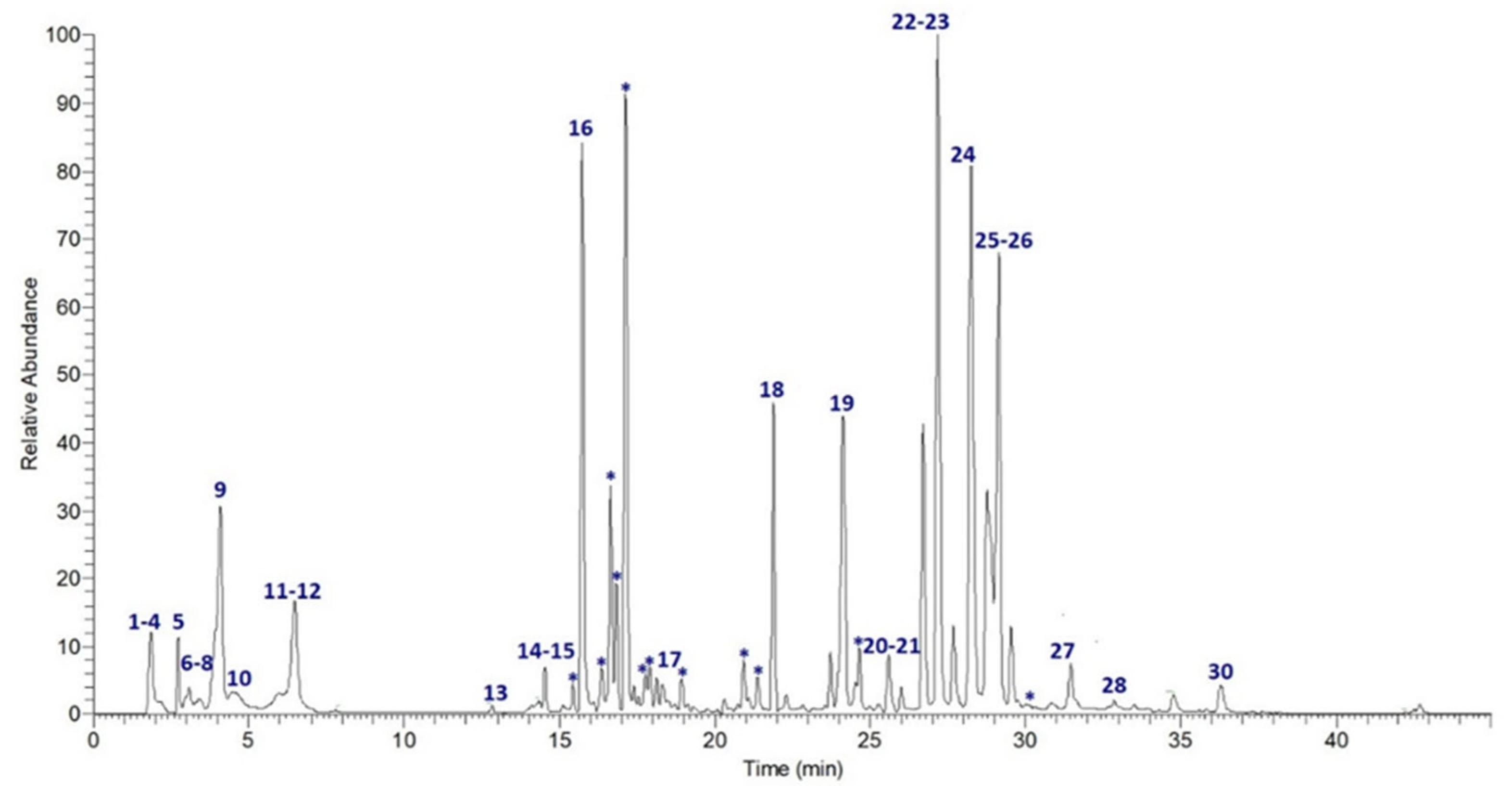
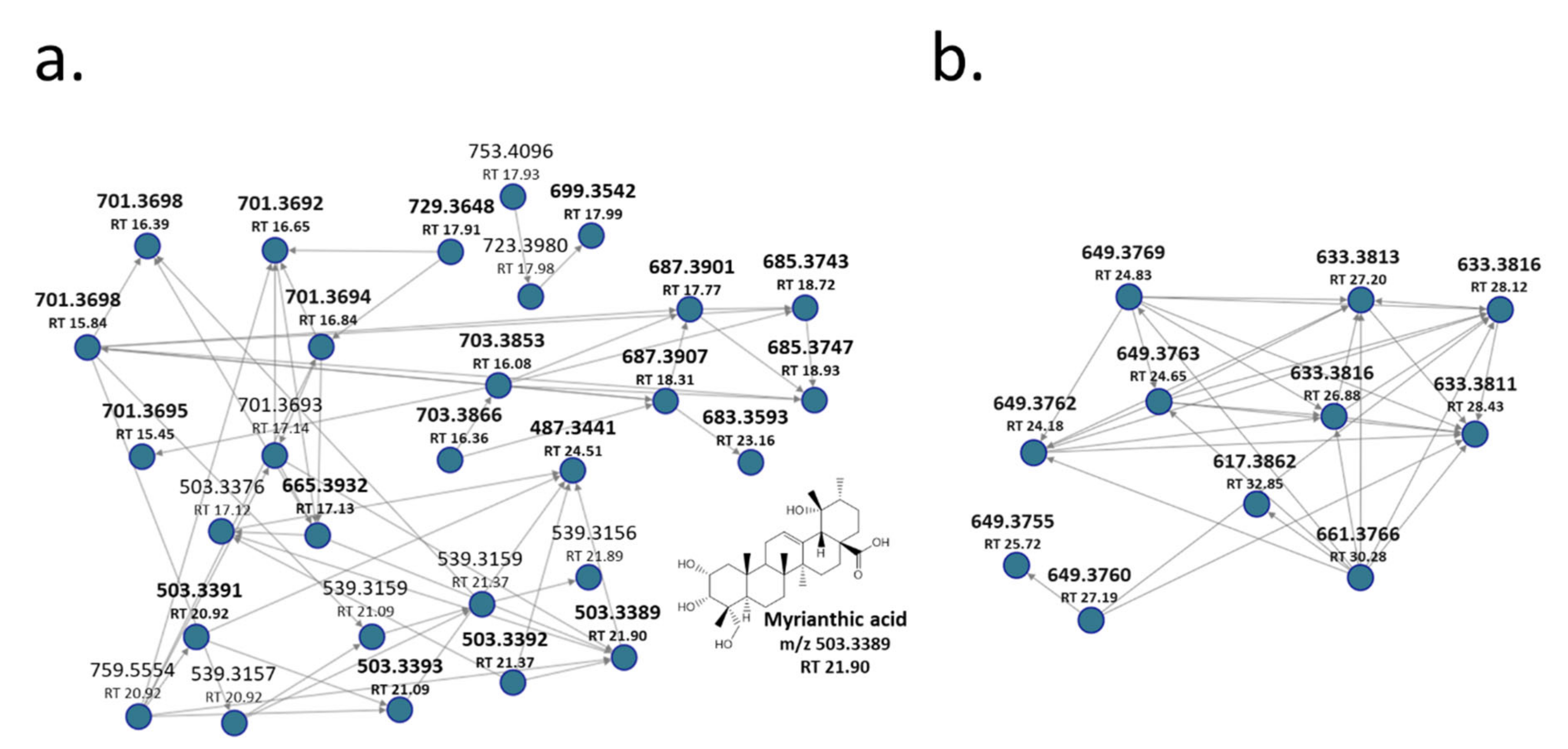
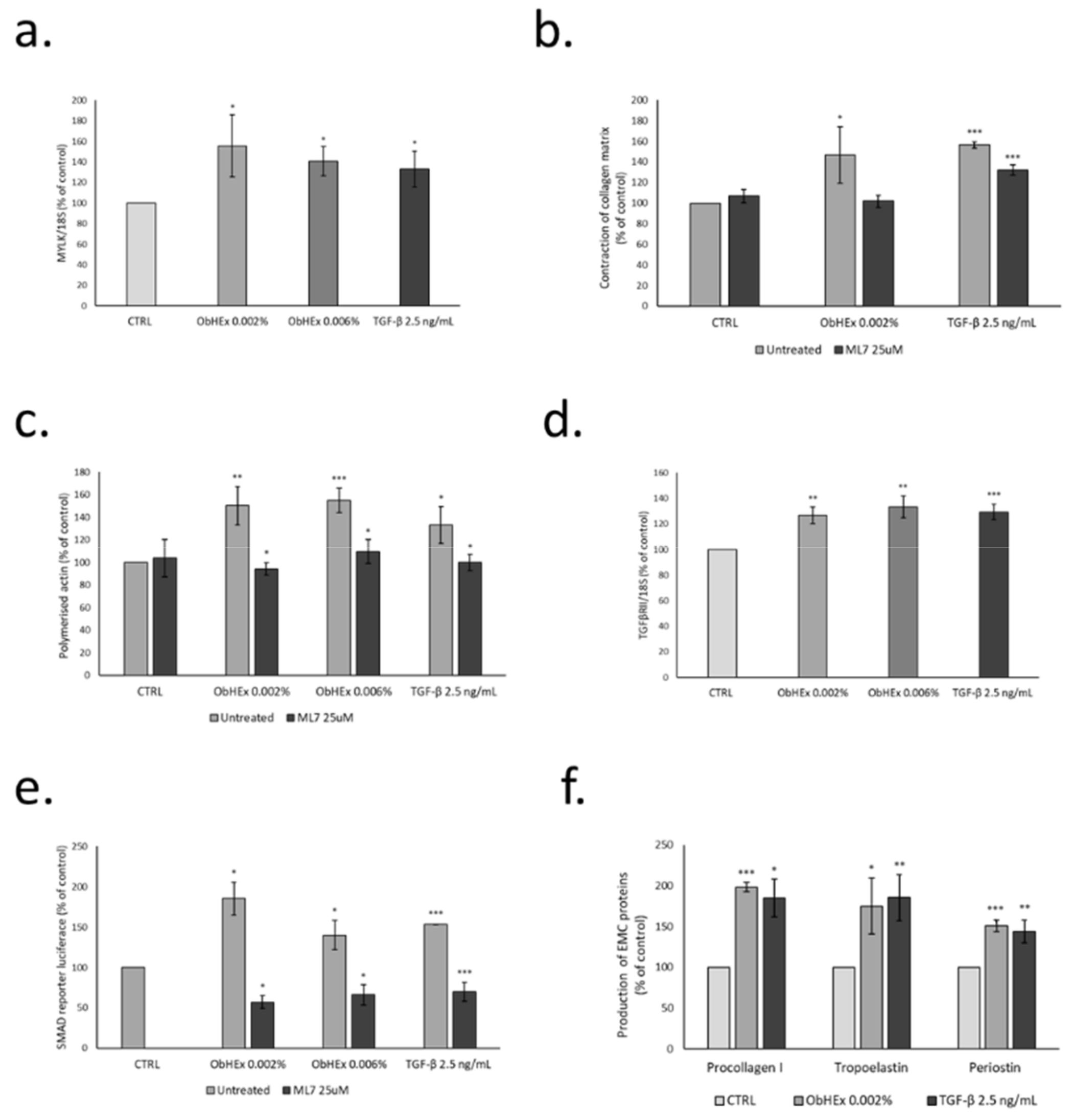
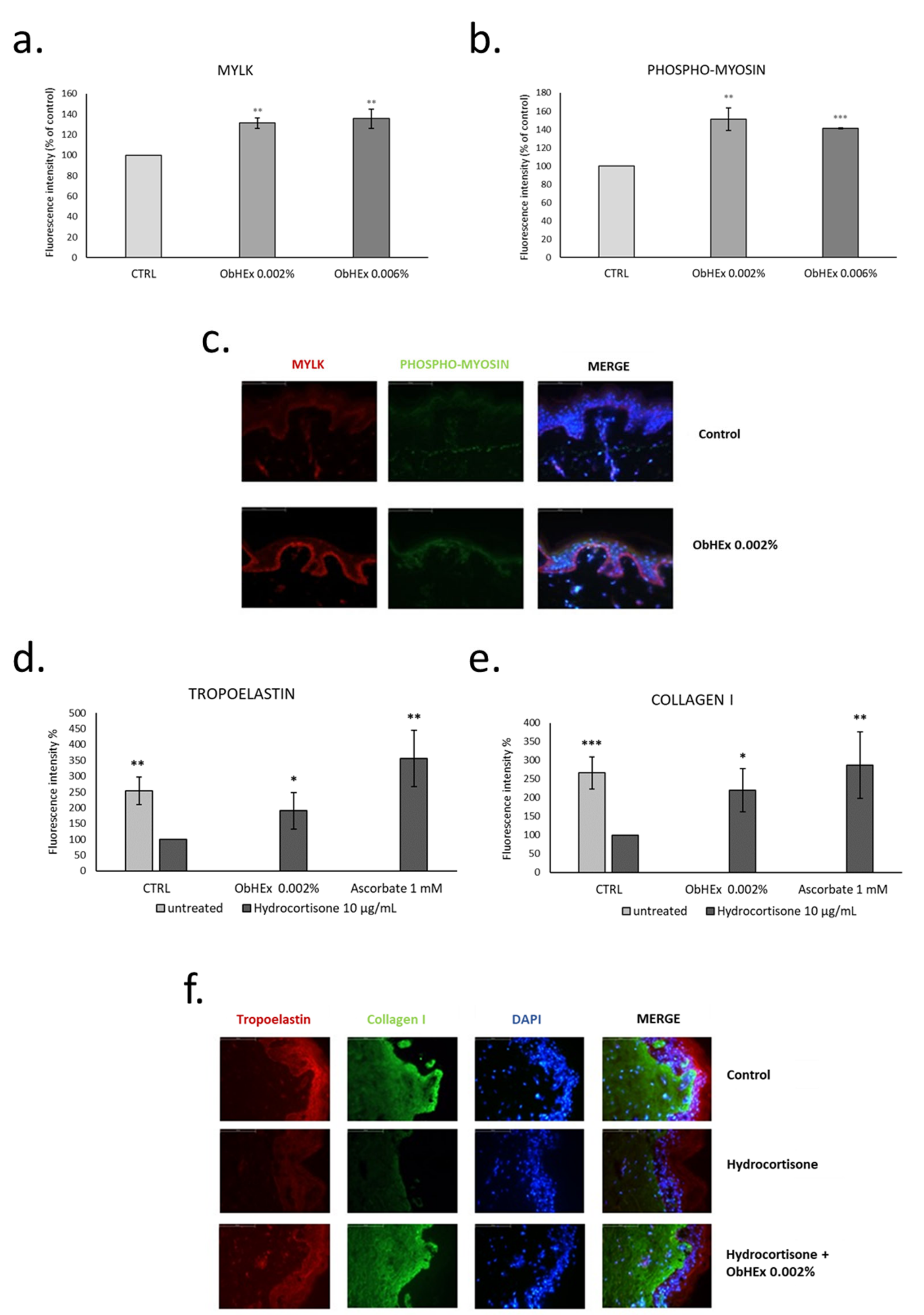
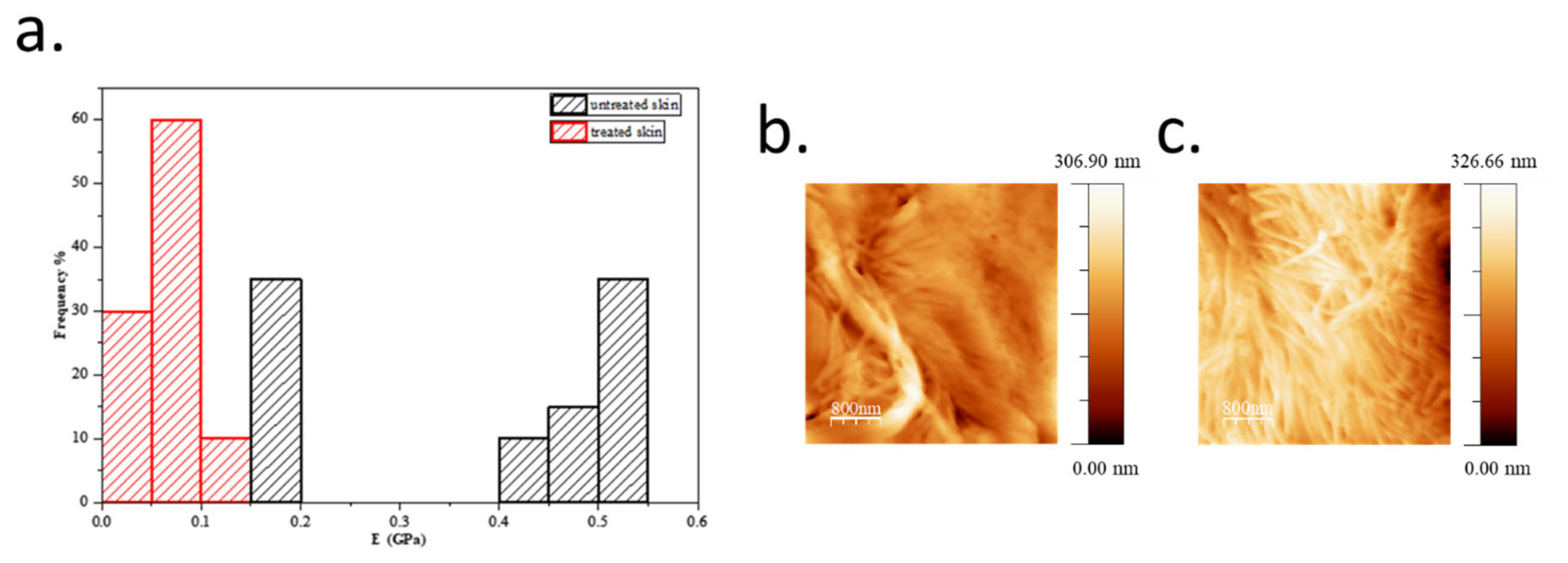
| Compound | MF (Mass Error ppm) | RT Min | Precursor Ions m/z | MS2 Ions m/z (Relative Intensity %) | |
|---|---|---|---|---|---|
| 1 | Allantoin | C4H6N4O3 (2.5 ppm) | 1.79 | 157.0360 | 114.0297 (87.36); 97.0031(100) |
| 2 | Pyridoxine | C8H11NO3 (2.4 ppm) | 1.79 | 168.0660 | 150.0550 (100); 122.0599 (45.03) |
| 3 | Cyclic Adenosine Monophosphate | C10H12N5O6P (5.8 ppm) | 1.88 | 328.0460 | 134.0461 (100) |
| 4 | Citric acid | C6H8O7 (4.2 ppm) | 1.88 | 191.0194 | 111.0076 (52.28); 87.0075 (24.13) |
| 5 | L-tyrosine | C9H11NO3 (2.8 ppm) | 2.73 | 180.0661 | 163.0392 (100); 119.0491 (68.65) |
| 6 | Arbutin | C12H16O7 (6.6 ppm) | 2.95 | 271.0830 | 108.0205 (100); 71.0126 (5.30) |
| 7 | Adenosine | C10H13N5O4 (6.4 ppm) | 3.08 | 266.0901 | 134.0461 (100) |
| 8 | Xanthosine | C10H12N4O6 (6.0 ppm) | 3.39 | 283.0690 | 151.0252 (100) |
| 9 | L-phenylalanine | C9H11NO2 (3.0 ppm) | 4.08 | 164.0711 | 147.0441 (100); 72.0078 (31.97) |
| 10 | Hydroxybenzoic acid glucoside | C13H16O8 (6.4 ppm) | 4.43; 5.92 | 299.0780 | 179.0341 (2.00/23.36); 137.0233 (100/65.11) |
| 11 | Beta-D-fructofuranosyl 6-O-(4-hydroxybenzoyl)-alpha-D-glucopyranoside | C19H26O13 (4.8 ppm) | 6.46 | 461.1312 | 137.0234 (100); 93.0333 (16.37) |
| 12 | Panthothenic acid | C9H17NO5 (4.6 ppm) | 6.49 | 218.1033 | 146.0812 (75.65); 88.0391 (100) |
| 13 | Sinapyl alcohol diglucoside | C23H34O14 (3.8 ppm) | 12.84 | 533.1885 | 209.0814 (98.19); 194.0578 (100) |
| 14 | Salvadoraside | C34H48O18 (4.4 ppm) | 13.89; 14.11 | 743.2790 | 389.1612 (100) |
| 15 | Liriodendrin | C34H46O18 (4.4 ppm) | 14.35; 14.53 | 741.2633 | 417.1556 (41.89); 181.0498 (100) |
| 16 | Syringaresinol glucoside | C28H36O13 (3.8 ppm) | 15.73 | 579.2094 | 417.1560 (11.26); 181.0498 (100) |
| 17 | Hydroxydecanoate | C10H20O3 (4.3 ppm) | 18.37; 24.43 | 187.1337 | 169.1229 (2.26/2.99); 141.1273 (6.73/100) |
| 18 | Myrianthic acid | C30H48O6 (4.4 ppm) | 21.89 | 503.3389 | 485.3276 (51.41); 459.3505 (5.76) |
| 19 | Arjunolic acid and Asiatic acid | C30H48O5 (3.9 ppm) | 24.13 | 487.3437 | 421.3104 (1.85); 409.3099 (5.57) |
| 20 | Dihydroxyoctadecenoic acid | C18H34O4 (6.1 ppm) | 24.98; 25.61 | 313.2392 | 183.1383 (100); 129.0910 (67.67/56.97) |
| 21 | Glycerophosphocholine (18:3) | C26H48NO7P (4.3 ppm) | 25.27 | 562.3163 (M+HCOOH−H)− | 277.2172 (100); 224.0685 (0.97) |
| 22 | Glycerophosphoethanolamine (18:2) | C23H44NO7P (4.4 ppm) | 26.71; 27.17 | 476.2793 | 279.2328 (100); 196.0374 (1.27/11.69) |
| 23 | Glycerophosphocholine (18:2) | C26H50NO7P (4.6 ppm) | 26.79; 27.26 | 564.3322 (M+HCOOH−H)− | 279.2328 (100); 224.0688 (0.86/10.27) |
| 24 | Glycerophosphoethanolamine (16:0) | C21H44NO7P (5.1 ppm) | 27.68; 28.25 | 452.2795 | 255.2328 (100); 196.0373 (1.29/10.72) |
| 25 | Hederagenin | C30H48O4 (4.4 ppm) | 28.77 | 471.3490 | 405.3163 (2.40); 393.3136 (6.12) |
| 26 | Hydroxyoctadecadienoic acid | C18H32O3 (5.1 ppm) | 29.14; 29.53 | 295.2283 | 277.2172 (100); 171.1018 (64.06/58.66) |
| 27 | Glycerophosphoethanolamine (18:0) | C23H48NO7P (5.0 ppm) | 30.87; 31.47 | 480.3109 | 283.2643(100); 196.0373 (1.53/11.63) |
| 28 | Coumaroyl triterpene | C39H54O6 (4.0 ppm) | 32.85 | 617.3862 | 453.3399 (0.69); 145.0284 (54.98) |
| 29 | Gamma-Linolenic acid | C18H30O2 (5.4 ppm) | 34.11 | 277.2177 | 233.2277 (0.71); 163.9689 (0.36) |
| 30 | Hydroxypalmitic acid | C16H32O3 (6.3 ppm) | 36.28 | 271.2285 | 253.2173 (2.75); 225.2220 (100) |
| Compound | Range (nM) | Calibration Curve | R2 | LOD (nM) | LOQ (nM) |
|---|---|---|---|---|---|
| Salvadoraside | 250–25000 | y = 1 × 107 x | R2 = 1.0000 | 76 | 250 |
| Liriodendrin | 250–25000 | y = 2 × 107 x | R2 = 0.9995 | 76 | 250 |
| Myrianthic acid | 100–25000 | y = 2 × 107 x | R2 = 0.9999 | 8 | 25 |
| Arjunolic acid | 100–25000 | y = 2 × 107 x | R2 = 0.9971 | 3 | 10 |
| Asiatic acid | 100–25000 | y = 3 × 107 x | R2 = 0.9911 | 3 | 10 |
| Hederagenin | 100–25000 | y = 4 × 107 x | R2 = 0.9967 | 3 | 10 |
| Compound | Amount (µg/g of Extract) | % RSD |
|---|---|---|
| Salvadoraside | 7.93 | 3.69 |
| Liriodendrin | 51.11 | 7.21 |
| Myrianthic acid | 22.09 | 3.85 |
| Arjunolic acid | 28.58 | 1.95 |
| Asiatic acid | 30.73 | 3.09 |
| Hederagenin | 78.21 | 0.61 |
Publisher’s Note: MDPI stays neutral with regard to jurisdictional claims in published maps and institutional affiliations. |
© 2021 by the authors. Licensee MDPI, Basel, Switzerland. This article is an open access article distributed under the terms and conditions of the Creative Commons Attribution (CC BY) license (https://creativecommons.org/licenses/by/4.0/).
Share and Cite
Ceccacci, S.; De Lucia, A.; Tito, A.; Tortora, A.; Falanga, D.; Arciello, S.; Ausanio, G.; Di Cicco, C.; Monti, M.C.; Apone, F. An Oenothera biennis Cell Cultures Extract Endowed with Skin Anti-Ageing Activity Improves Cell Mechanical Properties. Metabolites 2021, 11, 527. https://doi.org/10.3390/metabo11080527
Ceccacci S, De Lucia A, Tito A, Tortora A, Falanga D, Arciello S, Ausanio G, Di Cicco C, Monti MC, Apone F. An Oenothera biennis Cell Cultures Extract Endowed with Skin Anti-Ageing Activity Improves Cell Mechanical Properties. Metabolites. 2021; 11(8):527. https://doi.org/10.3390/metabo11080527
Chicago/Turabian StyleCeccacci, Sara, Adriana De Lucia, Annalisa Tito, Assunta Tortora, Danila Falanga, Stefania Arciello, Giovanni Ausanio, Chiara Di Cicco, Maria Chiara Monti, and Fabio Apone. 2021. "An Oenothera biennis Cell Cultures Extract Endowed with Skin Anti-Ageing Activity Improves Cell Mechanical Properties" Metabolites 11, no. 8: 527. https://doi.org/10.3390/metabo11080527
APA StyleCeccacci, S., De Lucia, A., Tito, A., Tortora, A., Falanga, D., Arciello, S., Ausanio, G., Di Cicco, C., Monti, M. C., & Apone, F. (2021). An Oenothera biennis Cell Cultures Extract Endowed with Skin Anti-Ageing Activity Improves Cell Mechanical Properties. Metabolites, 11(8), 527. https://doi.org/10.3390/metabo11080527








